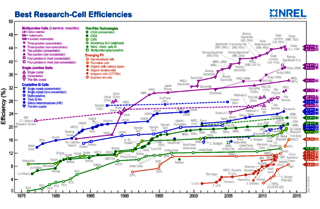A COMPARISON OF SOLAR PANELS EFFICIENCY

A DEFINITION AND CALCULATION OF PV EFFICIENCY
The rating table below compares published efficiency of top solar panel manufacturers. I have to note however that the data listed in the specification sheets are normally measured at an optimum load of the module under some ideal conditions called Standard Test Conditions (STC). This is of course convenient to compare apples to apples. However it is not very helpful for the consumers because in practice your system may rarely display its claimed characteristics. If you are interested in some technical details and facts, read on. If you just want to find out which panel claims the highest efficiency, go to the chart.
Likewise, your PV array will not necessarily operate at STC. For reference, STC is 1,000 watts/sq.m irradiance, 1.5 air mass and a 25 oC module temperature. The temperature greatly affects a PV cell operation as well. Given the fact a typical temperature coefficient of the crystalline silicon cells is around -0.5%/oC, the cells may be loosing 5% power for every 10oC heat up. In direct sunshine, a module may have temperature rise 15-25 oC above ambient. If for example its rated efficiency η=19% at STC, with 25oC overheat it would be only η=16.6%. The bottom line is, the data in the efficiency table are useful mainly for comparison purposes, but the estimation of actual power output is quite complex.
RATINGS COMPARISON TABLE
This ratings chart lists best solar panels rated above 100 watt with the highest efficiency at the time of this review (2017).
| Manufacturer | Model | Watts | Efficiency (%) | Vmp (V) | Imp (A) |
| SunPower | X21-345 | 345 | 21.5 | 57.3 | 6.0 |
| Crown Renewable Energy | CR100 | 100 | 18.3 | 17.6 | 5.7 |
| Xinhonglian Solar Energy | XHH135-24 | 135 | 18.01 | 36 | 3.8 |
| Zhejiang Shuqimeng Energy Tech. Co., Ltd. | SE230M-33A / D | 230 | 17.94 | 46.7 | 4.9 |
| Sanyo Electric | HIP-205BA19 | 205 | 17.7 | 56.7 | 3.6 |
| Shanghai Pubsolar | GYS-280D | 280 | 17.69 | 36.4 | 7.7 |
| Sanyo Electric | HIP-205BA20 | 205 | 17.66 | 56.7 | 3.6 |
| Titan Energy Systems | TITAN 32-300 | 300 | 17.24 | 53.8 | 5.5 |
| Enfoton Solar Ltd | 60E6M+245F(L) | 235 | 17.06 | 30.1 | 8.1 |
| Shanghai Pubsolar | GYS-270D (270) | 270 | 17.05 | 35.7 | 7.6 |
| Symphony Energy | SE-S160 | 160 | 16.95 | 30.2 | 5.4 |
| Conergy AG | STM 210 FWS | 210 | 16.88 | 40 | 5.3 |
| Millennium Electric T.O.U. Ltd. | MIL-PVT-215W-M03 | 215 | 16.84 | 38.2 | 5.6 |
| Maaß Regenerative Energien GmbH | BN 180-SP | 180 | 16.53 | 23.5 | 7.7 |
| Solara AG | SM 400SP | 100 | 16.52 | 17.8 | 5.6 |
| Centrosolar America | SM 400SP | 100 | 16.52 | 17.8 | 5.6 |
Note that we included above only one best model from each listed manufacturer. Some manufacturers such as SunPower, carry many high-efficient models. Our data are provided AS IS without guarantee of any type, neither explicit or implicit. See complete disclaimer linked below. Please contact me if you would like to submit or correct your device information.
 We see from the above table that the most efficient model has η≈22%. Note that a theoretical limit of a single-junction cell efficiency at "standard sun" conditions (known as Shockley-Queisser limit) is about 30%. You probably heard of record cell's efficiencies of up to 44%. The fact is, these results were obtained with multi-junction cells under concentrated light, which exceeded thousand times the normal amount of sunlight. For now, the concentrated solar energy technologies are suitable primarily for power plants rather than for home installations. For a reference, the chart to right shows the best PV cell efficiency achieved in research.
We see from the above table that the most efficient model has η≈22%. Note that a theoretical limit of a single-junction cell efficiency at "standard sun" conditions (known as Shockley-Queisser limit) is about 30%. You probably heard of record cell's efficiencies of up to 44%. The fact is, these results were obtained with multi-junction cells under concentrated light, which exceeded thousand times the normal amount of sunlight. For now, the concentrated solar energy technologies are suitable primarily for power plants rather than for home installations. For a reference, the chart to right shows the best PV cell efficiency achieved in research.REFERENCES AND ADDITIONAL FACTS
Best conversion efficiencies for various PV technologies.
